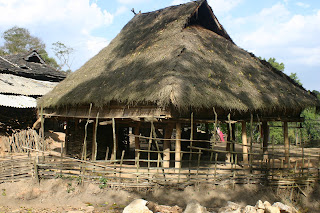We had the morning free and some suggested we visit their exquisite botanical garden. Well that garden was too far away to visit before catching our plane home. This garden was wonderful.
 Here is the opening sign. I neglected along the way to say that temperatures here in Xishuangbanna were in the mid 70's. The azaleas were in full bloom. I also must say that we were told that 80% of all plants in China and 60% of all animals originated from Yunnan province.
Here is the opening sign. I neglected along the way to say that temperatures here in Xishuangbanna were in the mid 70's. The azaleas were in full bloom. I also must say that we were told that 80% of all plants in China and 60% of all animals originated from Yunnan province.  Tom noticed this beautiful plant with variegated leaves and azalea like blossoms.
Tom noticed this beautiful plant with variegated leaves and azalea like blossoms.
Look at the tree at the end of this lane. There is a palm tree right? You are partly correct, there is a palm tree but a banyan tree is growing around it. Eventually the banyan tree will kill the palm tree and there will be a hole in the center of the banyan tree.
 This is a close up of the trunk of the tree with the palm tree peeking through.
This is a close up of the trunk of the tree with the palm tree peeking through.
 This awesome tree is about three feet across on the one side and skinny as heck when viewed sideways like this. How cool is that?
This awesome tree is about three feet across on the one side and skinny as heck when viewed sideways like this. How cool is that?
 Concrete lily pads across the water. See Tom on the far shore?
Concrete lily pads across the water. See Tom on the far shore? I am enjoying a wonderful ride over the lake. Actually I got to ride the other way too!
I am enjoying a wonderful ride over the lake. Actually I got to ride the other way too!
A beautiful archway of flowers.

I miss not seeing the lotus in Beijing. Here they are.
 It is time to go home and there is my basket ready to get on the plane. I tied a smaller basket to the top with strong, sturdy sock yarn. That knitting habit comes in handy sometimes. Speaking of knitting yarn. I lost a button right in the middle of my shirt one morning as soon as we took off in the bus. I had nothing with me but my yarn needle and sock yarn. I sewed three places along the front of my shirt to make it look decent. Thanks Mom for teaching me all the tricks.
It is time to go home and there is my basket ready to get on the plane. I tied a smaller basket to the top with strong, sturdy sock yarn. That knitting habit comes in handy sometimes. Speaking of knitting yarn. I lost a button right in the middle of my shirt one morning as soon as we took off in the bus. I had nothing with me but my yarn needle and sock yarn. I sewed three places along the front of my shirt to make it look decent. Thanks Mom for teaching me all the tricks.























 The village of Man
The village of Man 





 We drove past fields laid out so orderly. It was pretty. Do you see the tea trees (bushes) on the hill in the distance?
We drove past fields laid out so orderly. It was pretty. Do you see the tea trees (bushes) on the hill in the distance? 








 As we were leaving there were many trucks carrying sugar cane to the factory in the village.
As we were leaving there were many trucks carrying sugar cane to the factory in the village.
